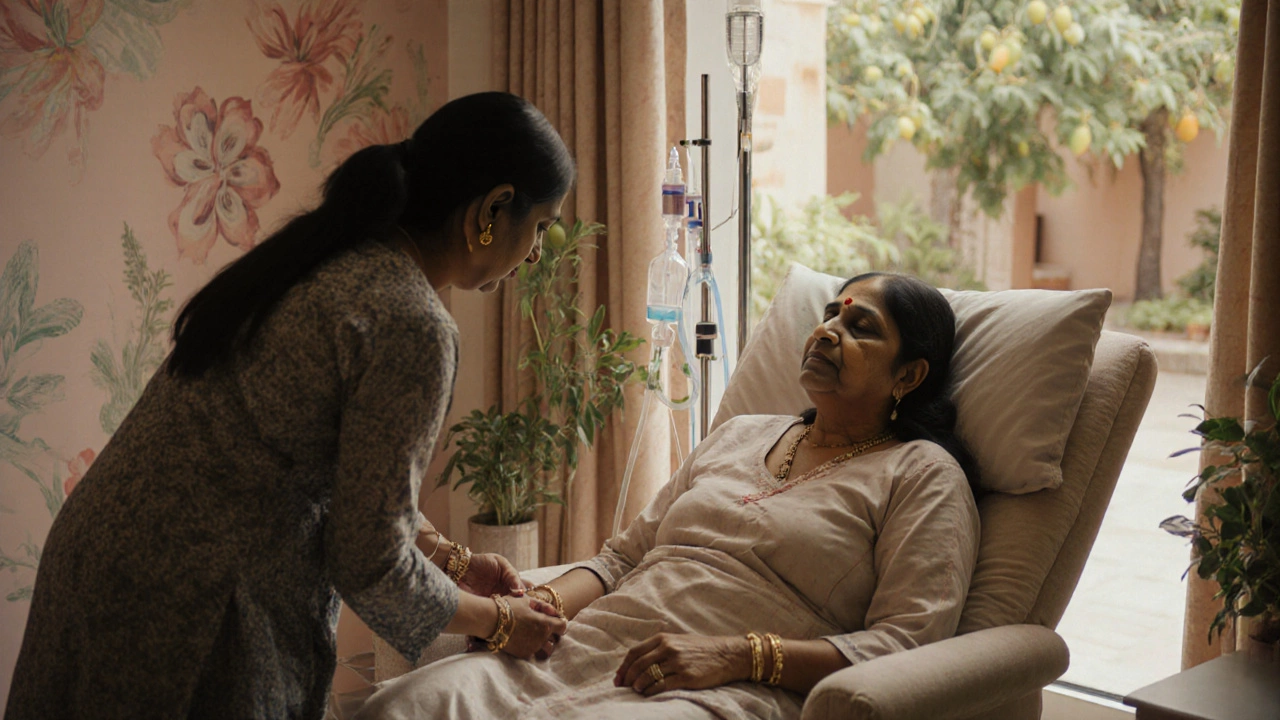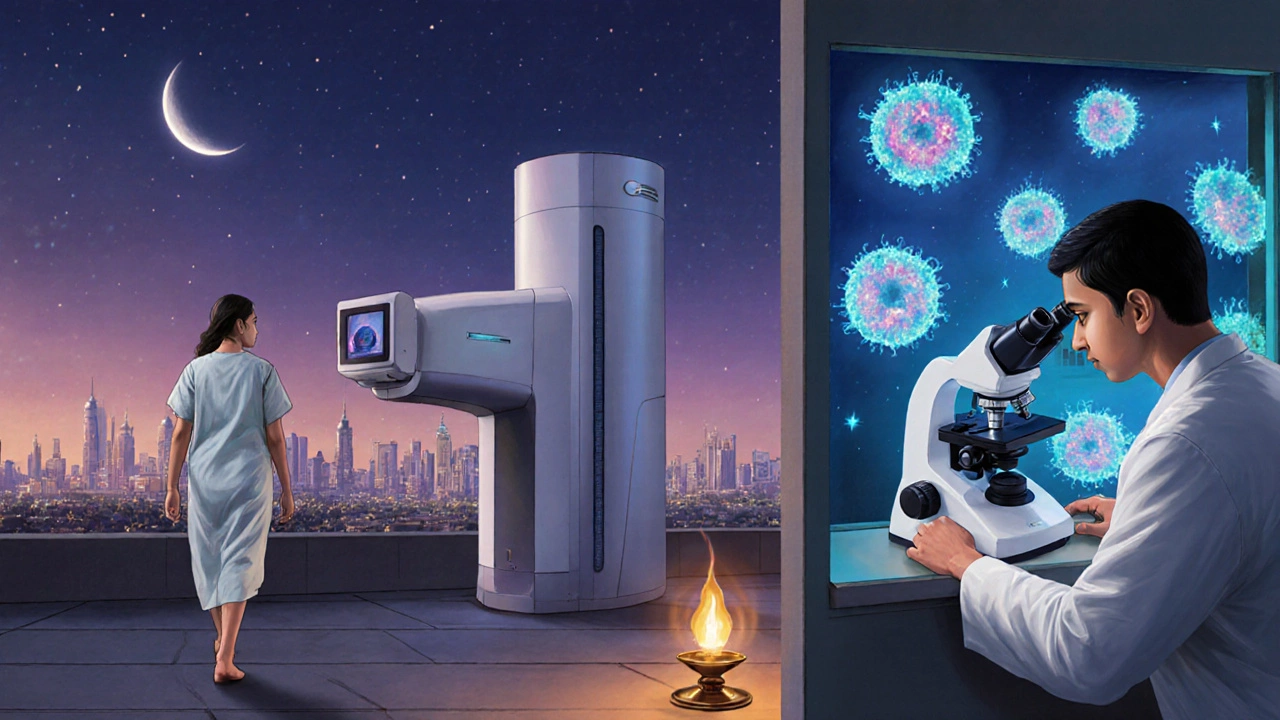Cancer Treatment Selector
Select Cancer Type
Select Cancer Stage
Recommended Treatment Options
Cancer treatment is a multidisciplinary medical approach aimed at eradicating or controlling malignant cells in the body. It encompasses several modalities, each targeting the disease from a different angle.
When a patient receives a diagnosis, the most pressing question is what will be done to fight the disease. The answer depends on tumor type, stage, patient health, and evolving scientific evidence. This guide breaks down the main treatment pillars, compares their strengths and drawbacks, and shows how a team of specialists tailors a plan for each individual.
Understanding the Cancer Treatment Landscape
Oncologists categorize therapies into three broad groups: local, systemic, and biologic. Local treatments aim to destroy the tumor in place, while systemic therapies travel through the bloodstream to reach cancer cells wherever they hide. Biologic approaches harness the body’s own immune system or target specific molecular pathways.
Each modality has its own set of goals-curative intent for early‑stage disease, disease‑control for advanced cancer, or palliation to relieve symptoms. Knowing where a particular option fits helps patients set realistic expectations.
Surgery: Cutting Out the Problem
Surgery is a local treatment that physically removes tumor tissue. When the cancer is confined to one organ or region, surgical excision offers the highest chance of cure. Procedures range from minimally invasive laparoscopic resections to complex multi‑organ operations.
- Goal: Complete removal of visible disease (R0 resection).
- Typical Use: Early‑stage solid tumors such as breast, colorectal, lung, and prostate cancer.
- Common Side Effects: Pain, infection, scarring, and organ‑specific functional loss.
Advances like robotic assistance and intra‑operative imaging have reduced complications, but surgery still carries risks that must be weighed against its curative potential.
Chemotherapy: Systemic Chemical Assault
Chemotherapy is a systemic treatment that uses cytotoxic drugs to kill rapidly dividing cells. These drugs travel through the bloodstream, reaching cancer cells that have spread beyond the primary site.
- Goal: Shrink tumors, eradicate microscopic disease, or prolong survival.
- Typical Use: Hematologic malignancies (leukemia, lymphoma) and solid tumors that are not resectable.
- Common Side Effects: Nausea, hair loss, fatigue, neutropenia, and increased infection risk.
Regimens are often combined (e.g., CHOP for lymphoma) and given in cycles to allow normal tissue recovery. Supportive drugs like anti‑emetics and growth factors improve tolerability.
Radiation Therapy: Precise Energy Delivery
Radiation therapy is a local treatment that uses high‑energy photons or particles to damage DNA within cancer cells. Modern techniques such as intensity‑modulated radiation therapy (IMRT) and proton therapy sculpt the dose to match tumor shape, sparing healthy tissue.
- Goal: Destroy tumor cells in a defined volume.
- Typical Use: Head‑and‑neck cancers, prostate cancer, and as adjuvant post‑surgery.
- Common Side Effects: Skin irritation, fatigue, organ‑specific toxicity (e.g., esophagitis).
When combined with chemotherapy (chemoradiation), the two modalities can act synergistically, improving local control rates.
Immunotherapy: Enlisting the Immune System
Immunotherapy is a biologic treatment that stimulates or restores the immune system’s ability to recognize and kill cancer cells. Checkpoint inhibitors (e.g., pembrolizumab) block proteins that tumors use to hide from immune attack, while CAR‑T cell therapy engineers a patient’s T cells to target specific antigens.
- Goal: Achieve durable, sometimes lifelong, disease control.
- Typical Use: Melanoma, non‑small cell lung cancer, Hodgkin lymphoma, and certain bladder cancers.
- Common Side Effects: Immune‑related adverse events-colitis, dermatitis, endocrinopathies.
Response rates vary, but when effective, immunotherapy can produce responses that last years after treatment stops.

Targeted Therapy: Hitting Molecular Switches
Targeted therapy is a drug class that blocks specific molecules involved in cancer growth and spread. Examples include tyrosine‑kinase inhibitors (e.g., erlotinib for EGFR‑mutated lung cancer) and PARP inhibitors for BRCA‑mutated ovarian cancer.
- Goal: Interrupt oncogenic signaling pathways.
- Typical Use: Cancers with identifiable driver mutations.
- Common Side Effects: Skin rash, diarrhea, liver enzyme elevation.
Genomic testing is essential to match patients with the right targeted agent, making precision medicine a cornerstone of modern oncology.
Hormone Therapy: Blocking Growth Signals
Hormone therapy is a treatment that interferes with hormone‑driven tumor growth. In breast cancer, drugs like tamoxifen block estrogen receptors; in prostate cancer, androgen deprivation therapy lowers testosterone levels.
- Goal: Starve hormone‑sensitive tumors.
- Typical Use: ER‑positive breast cancer, androgen‑dependent prostate cancer.
- Common Side Effects: Hot flashes, bone loss, sexual dysfunction.
Hormone therapy is often given for years, helping to keep disease in check after initial surgery or radiation.
The Multidisciplinary Team: Tailoring the Right Mix
Multidisciplinary team is a group of specialists-including medical oncologists, surgeons, radiation oncologists, pathologists, and nurses-who collaborate to design an optimal treatment plan. Their collective expertise ensures that each modality is considered, sequenced correctly, and aligned with the patient’s preferences.
- Role: Evaluate disease stage, discuss clinical trial options, manage side‑effects.
- Benefit: Higher cure rates, better quality‑of‑life outcomes, reduced duplication of tests.
Patients are encouraged to ask questions, understand the rationale behind each recommendation, and voice personal goals-whether that’s a focus on cure, longevity, or symptom relief.
Comparison of Major Cancer Treatment Modalities
| Modality | Primary Goal | Typical Use Cases | Common Side Effects |
|---|---|---|---|
| Surgery | Complete tumor removal | Early‑stage solid tumors | Pain, infection, scarring |
| Chemotherapy | Kill rapidly dividing cells | Advanced solid tumors, hematologic cancers | Nausea, alopecia, neutropenia |
| Radiation Therapy | DNA damage within a defined volume | Local control, adjuvant post‑surgery | Skin irritation, fatigue |
| Immunotherapy | Activate immune response | Melanoma, NSCLC, Hodgkin lymphoma | Autoimmune‑like reactions |
| Targeted Therapy | Block oncogenic pathways | Mutation‑driven cancers | Rash, diarrhea, liver toxicity |
| Hormone Therapy | Disrupt hormone signaling | ER‑positive breast, androgen‑dependent prostate cancer | Hot flashes, bone density loss |
Emerging Trends: Personalized Medicine and Clinical Trials
Beyond the classic pillars, the field is shifting toward ultra‑personalized regimens. Next‑generation sequencing (NGS) can identify dozens of actionable mutations, guiding the choice of targeted agents or enrollment in basket trials.
Liquid biopsies-blood tests that detect circulating tumor DNA-allow clinicians to monitor treatment response in real time, adjusting therapy before imaging shows progression.
Clinical trials remain the fastest pathway to access novel drugs. Patients who fit trial eligibility often experience outcomes comparable to or better than standard care, especially in aggressive or refractory disease.
Key Takeaways
- There is no one‑size‑fits‑all; the best approach blends surgery, systemic drugs, and biologic therapies based on tumor biology and patient health.
- Understanding each modality’s goal, typical use, and side‑effect profile empowers patients to make informed decisions.
- The multidisciplinary team is the engine that translates scientific options into a personalized roadmap.
- Advances in genomics and immunology are expanding the toolbox, making precision oncology a reality for more patients.

Frequently Asked Questions
What determines whether surgery is recommended?
Surgery is usually advised when the tumor is localized, the patient’s overall health can tolerate an operation, and clear margins (no residual cancer) are achievable. Imaging studies, biopsy results, and staging guide the decision.
Can chemotherapy be combined with other treatments?
Yes. Chemotherapy often works synergistically with radiation (chemoradiation) or is given before surgery (neoadjuvant) to shrink tumors. It can also follow surgery (adjuvant) to eliminate microscopic disease.
What are the main side effects of immunotherapy?
Immune checkpoint inhibitors can trigger inflammation in any organ, most commonly the colon (colitis), skin (rash), lungs (pneumonitis), and endocrine glands (thyroiditis). Early detection and steroids usually keep them manageable.
How does targeted therapy differ from chemotherapy?
Targeted therapy zeroes in on a specific molecular abnormality that drives the cancer, sparing many normal cells. Chemotherapy attacks all fast‑dividing cells, leading to broader toxicity. Molecular testing is required before prescribing a targeted drug.
Is hormone therapy used for cancers other than breast and prostate?
Yes, certain gynecologic cancers (e.g., endometrial) and adrenal tumors also rely on hormonal pathways and may benefit from hormone‑blocking agents, though breast and prostate remain the most common scenarios.
